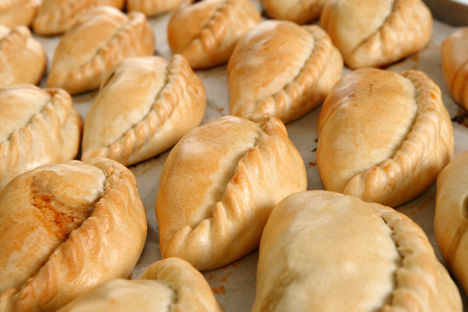
Cornish pride: a history of the pasty
From the dark mines of South West England to global recognition and a dedicated museum in Mexico, Tom Shingler uncovers the story of the Cornish pasty.
Cornish pride: a history of the pasty
From the dark mines of South West England to global recognition and a dedicated museum in Mexico, Tom Shingler uncovers the story of the Cornish pasty.
If you’ve been lucky enough to visit a Cornish bakery or even if you’re just captivated by the smells wafting out of pasty shops inside train stations, one thing’s for certain – Cornish pasties are universally loved. That simple combination of buttery shortcrust pastry and chunks of beef, root vegetables and gravy is hard to resist, especially when you’re hungry – just imagine how much Cornwall’s miners looked forward to their lunch after spending all morning underground, doing backbreaking manual labour.
We can trace Cornish pasties way back to the thirteenth century, when the first references were written during the reign of Henry III. The speciality gradually grew in popularity, and by the end of the eighteenth century it was firmly established as the staple diet for working men across Cornwall. They were the ideal food for poor working families, who could only afford cheap ingredients like potato, swede and onion (adding meat to the pasty came later), while miners and farmers liked it because it was durable, easy to carry and the thick pastry stopped the filling from spilling out. By the early twentieth century, Cornish pasties were being mass-made for workers across the UK.
For a food that (at first) sounds pretty humdrum, the Cornish pasty has an amazing amount of history behind it. As you’d imagine, such an iconic food has quite a few stories, myths and legends surrounding it. Its iconic ‘D’ shape is thought to have been designed for tin miners; their hands were often covered in arsenic, so the circular shape meant they could hold the pasty by the crust and then throw it away once they were finished. People would also have their initials carved into the crust before baking, so everyone could keep track of which pasty was theirs, and there was even a trend for the pastry to contain both a sweet and savoury filling – one at each end – so workers could enjoy both main and dessert when down in the mines or out in the fields.
Across the pond
Nowadays Cornish pasties are sold and eaten across the UK, but the delicacy’s reputation reaches across the world. In fact, the world’s first Cornish pasty museum is in Real del Monte, Mexico – possibly one of the last places you’d expect to find one. However, the pastry has been incredibly popular here since 1824, when a group of Cornish miners travelled to the country to help build the local mining industry. They brought their beloved pasties with them (along with their favourite sport, football), and the locals soon started adapting it to what ingredients they had access to. Swede and beef weren’t readily available, so peppers, chicken, pineapple and chilli sauce was used as a substitute. The paste was born, and continues to thrive today.
Protecting the pasty
By the late twentieth century, pasties were big business. They were being made across the UK (using ingredients of varying quality), and people began chopping and changing the recipe to whatever they liked. This didn’t go down well with Cornish bakers, who were very proud of their historic delicacy and worried that its reputation was being tarnished by these inferior imitations, so they banded together to apply for EU protected food status. Their wish was answered and, in 2011, the Cornish pasty was awarded PGI status.
This meant all sorts of rules and regulations came into force to ensure anything labelled Cornish pasty was made in a particular way. One of the most important rules was that they had to be made in Cornwall, providing a huge boost for the county’s bakers. They also have to be made in the distinctive ‘D’ shape, with the crust on one side instead of on top. The filling can only include potato, swede, onion, diced or minced beef, salt and pepper, and must be ‘crimped’ rather than pinched to seal. Crimping is a very traditional technique which sort of weaves the pastry together, making a robust and attractive pattern around the edge.
For what started off as a humble, practical recipe made for people working in harsh conditions, the pasty is now regularly voted one of the top hundred foods in the world. So next time you’re passing a bakery on the high street or grabbing a hot pasty to eat on the train home, just take a moment to think how far the Cornish pasty has come.

